This post may contain affiliate links, see our disclosure policy for details.
Toast with a delicious spread is a quick and easy go-to meal or snack when you’re busy. It can be prepped in under 2 minutes and, with the right topping, can offer great nutrition for your baby.
But on the flip side, it’s easy to fall into a routine of offering the same toast topping over and over again.
That’s why we’re so excited to share our top 12 nutritious, dietitian-approved toppings for your baby’s toast! We’ll also provide you with over 80 unique combinations to try, highlight the benefits of each topping, and guide you on which toppings to avoid.

Table of Contents
If you’re looking for baby-friendly recipes, don’t forget to check out our 60 Day Baby Led Feeding Meal Plan!
Take the stress out of deciding what meals to serve and how to safely serve them to your baby with access to over 60 dietitian-approved recipes, weekly grocery lists, serving and nutrition tips, and more!
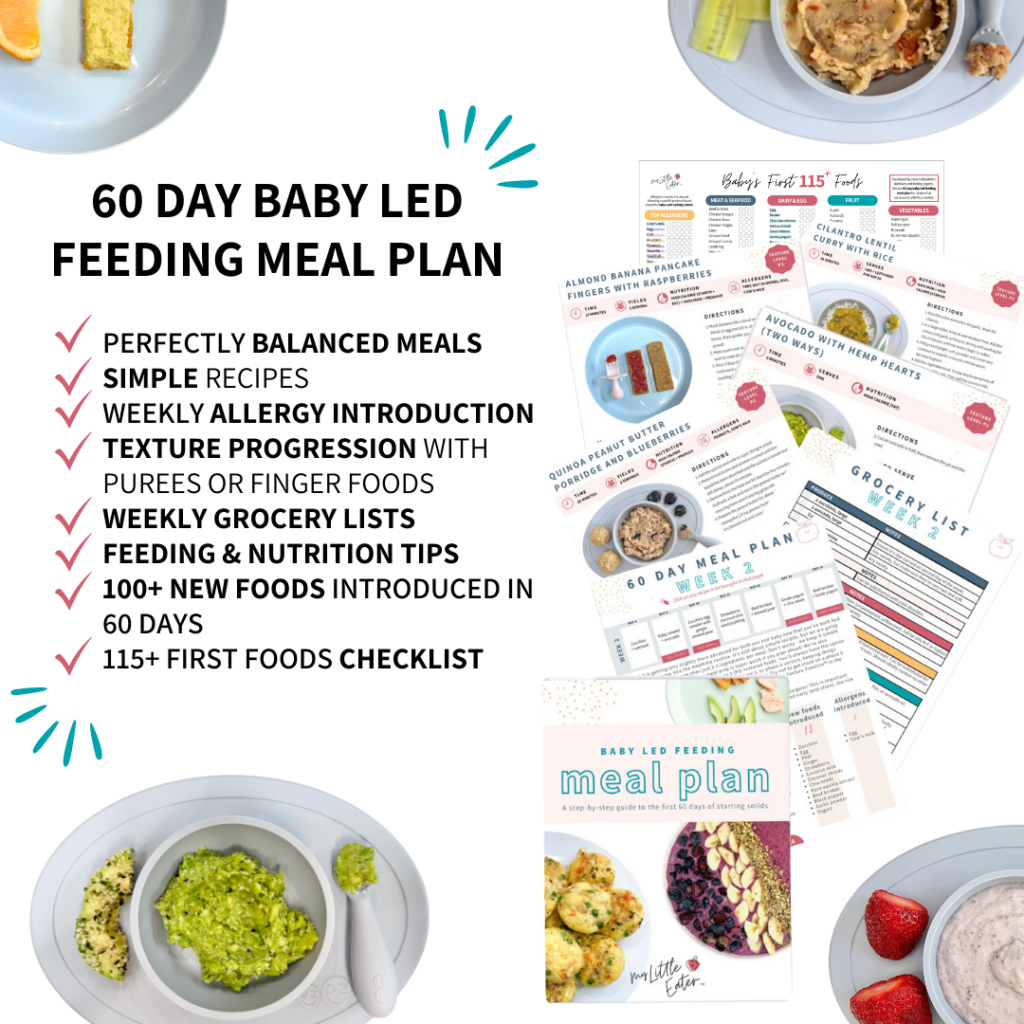
If you’re looking for baby-friendly recipes, don’t forget to check out our 60 Day Baby Led Feeding Meal Plan!
Take the stress out of deciding what meals to serve and how to safely serve them to your baby with access to over 60 dietitian-approved recipes, weekly grocery lists, serving and nutrition tips, and more!

When can babies eat toast?
Toast can be introduced at around 6 months of age. This may vary by a few weeks either way, and the exact age will depend on whether your baby is showing all the developmental signs of readiness for starting solid foods.
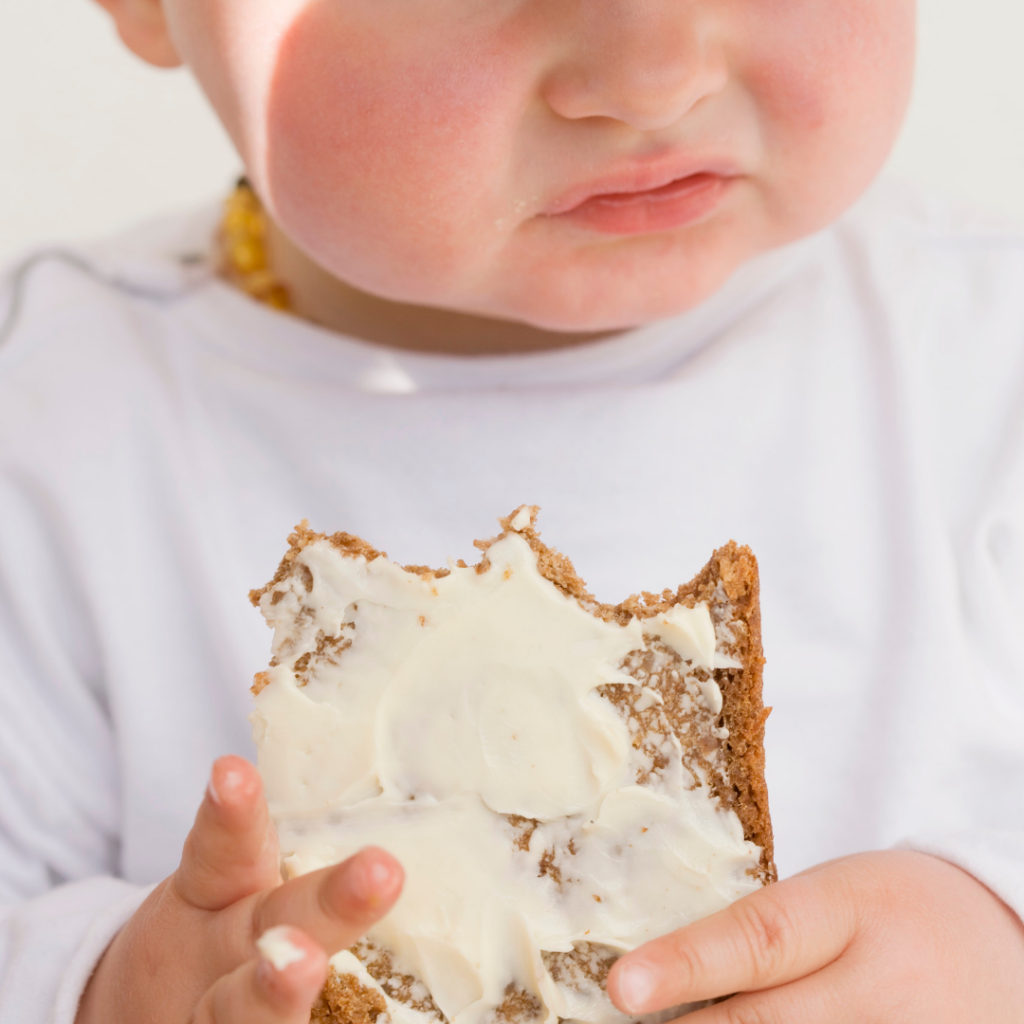
Toast is actually one of the first foods we recommend for starting your baby on solids! It’s important to note that while toast is safe for babies to eat at 6 months, fresh or un-toasted bread isn’t, and is considered a choking hazard.
Toast is also an easy way to introduce one of the top allergens – wheat! As a top allergen, it’s important to introduce wheat early in their starting solids journey (recommendations are for between 4-6 months or as soon as they begin solids) and to continue to expose them to it frequently to prevent an allergy from developing later on.
Learn more about the proper protocol for introducing highly allergenic foods.
80+ healthy toast topping combos
We’ve created a comprehensive list of 12 base toast toppings for your baby, then expanded it by including various mix-ins and additions to come up with over 80 delicious combinations to explore!
Be sure to screenshot or pin the image below for quick and easy access whenever you need fresh toast topping ideas.
Let’s dive into what each toast topping base has to offer!
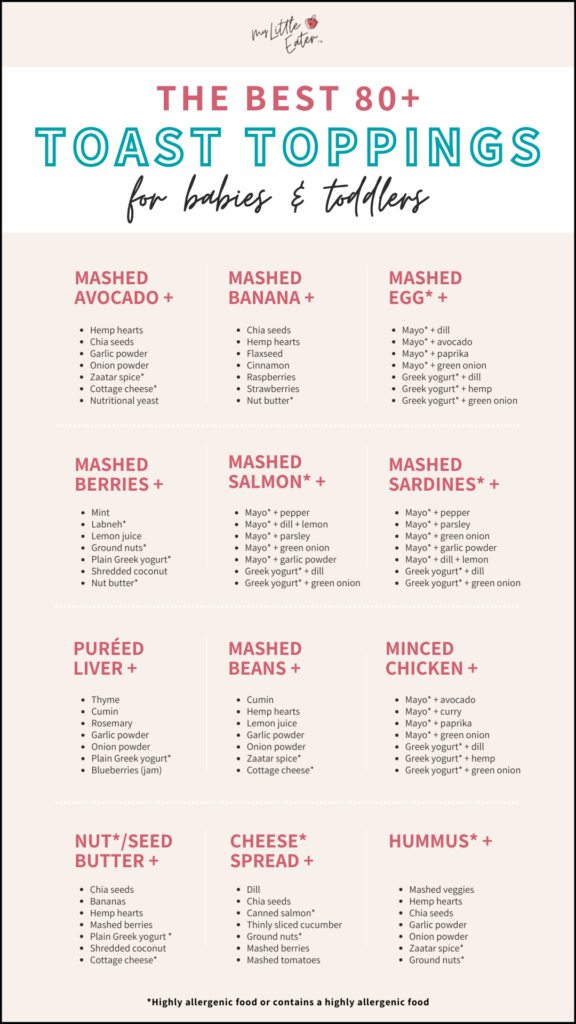
A note on highly allergenic foods
Throughout the combinations listed below, we’ve included an asterisk (*) beside any food that is a top allergen. This is because bread is already a top allergen (wheat) and all top allergens need to be introduced separately.
Therefore, if you’re making a combination that also includes one or more ingredients with an asterisk (*), you need to ensure that at least one (or two if the combination has 3 allergens) have already been ruled out as an allergen. This means that only one of the top allergens is being introduced as a new food for your baby.
Mashed avocado
We absolutely love avocado toast for your baby or toddler! It’s packed with healthy fats and is a high-calorie food that supports proper growth and development (1). Avocados are also a fantastic source of fiber, vitamins E, K, C, and many other nutrients to help your little one thrive (1).
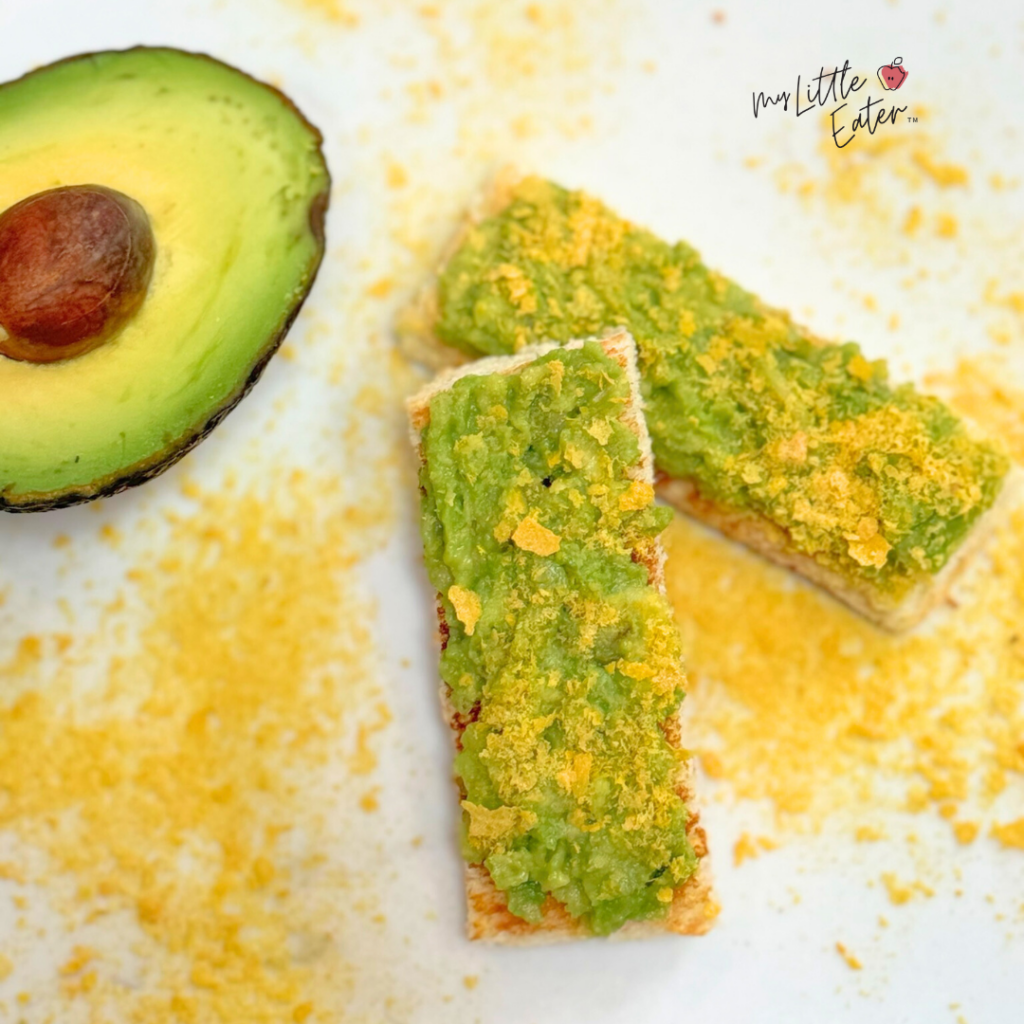
For extra flavor and a nutritional boost, try pairing avocado with any of the following ingredients:
- Hemp hearts
- Chia seeds
- Garlic powder
- Onion powder
- Zaatar spice*
- Cottage cheese*
- Nutritional yeast
- Chicken
- Salmon*
- Sardines*
- Eggs*
Mashed banana
This is one of the simplest toast toppings on our list! Not only does banana add fiber, but it also provides potassium and other essential nutrients for your little one (2).
While toast and banana are rich in fiber, we suggest balancing the meal by adding protein and a healthy fat source (like hemp hearts, chia seeds, flaxseed, or nut butter). This helps boost the nutrition and keeps your little one full for longer!
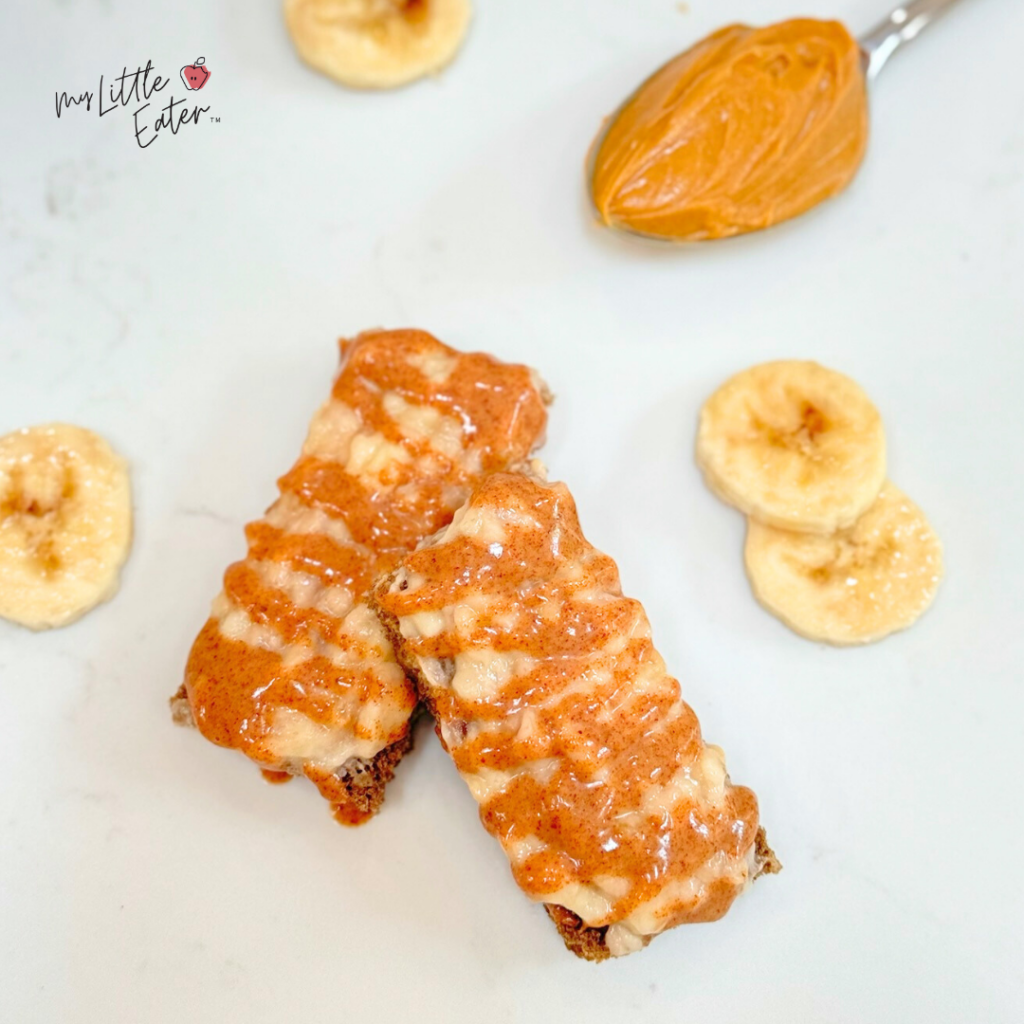
For extra flavor and a nutritional boost, try pairing banana with any of the following ingredients:
- Chia seeds
- Hemp hearts
- Flaxseed
- Cinnamon
- Raspberries
- Strawberries
- Nut butter (peanut, almond, cashew, etc.)*
- Seed butter (sunflower, pumpkin, etc.)
- Ground nuts*
- Shredded unsweetened coconut
Mashed egg*
Mashed eggs mixed with Greek yogurt make for a nutritious toast topping that’s a complete meal on its own! This combination is rich in healthy fats, calories, iron, and protein, keeping your baby or toddler satisfied for longer (3).
You can boil the eggs ahead of time, fry them, or scramble one on the spot, then mash it and mix it with whole-fat yogurt for an easy-to-spread, delicious topping.
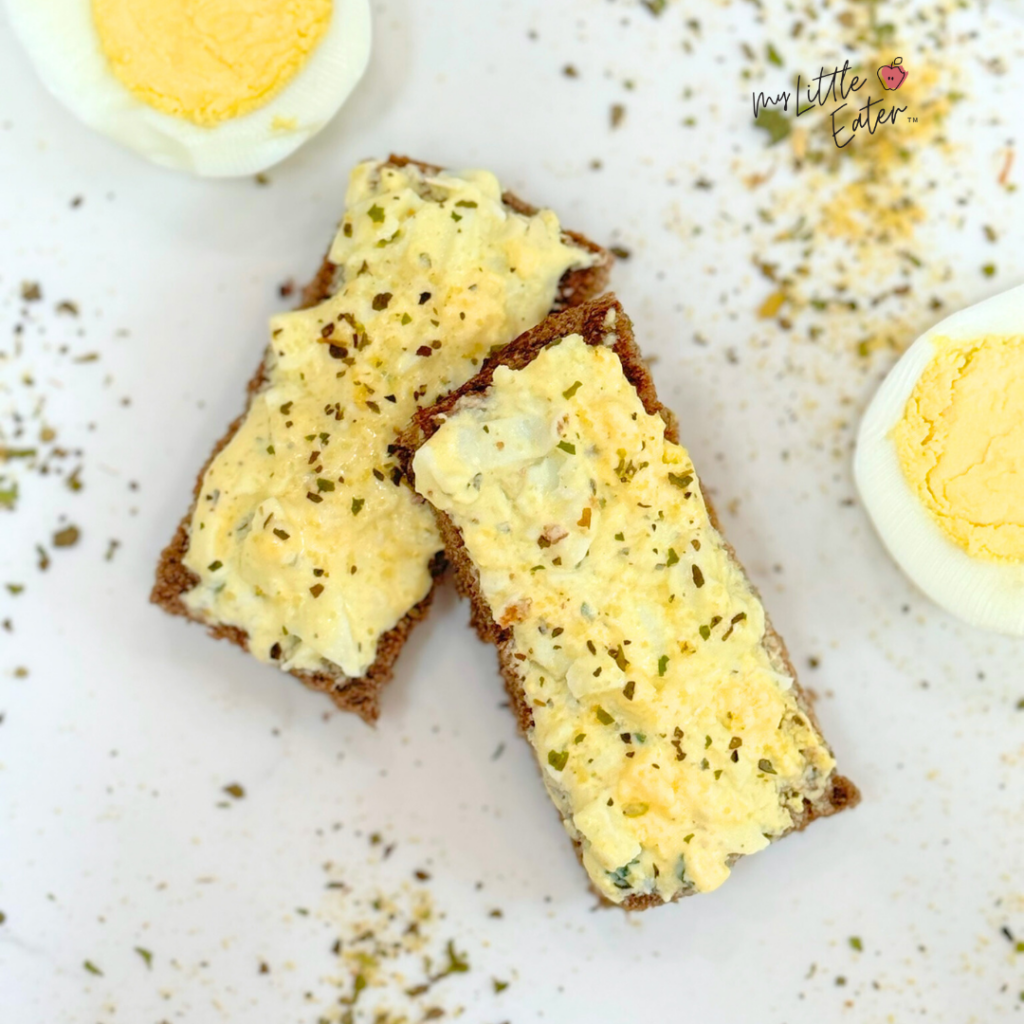
For extra flavor and a nutritional boost, try pairing eggs with any of the following ingredients:
- Mayo* + dill
- Mayo* + avocado
- Mayo* + paprika + garlic powder
- Mayo* + green onion
- Greek yogurt* + dill + onion powder
- Greek yogurt* + hemp
- Greek yogurt* + green onion
Bonus tip: Fully cook the egg so that there’s no runny yolk before serving it to your baby to reduce the risk of foodborne illnesses.
Mashed berries
Using mashed fruit, like blueberries, as a toast topping for your baby or toddler is a wonderful way to add natural sweetness to a meal or snack without any added sugars! Homemade jam is another excellent choice since store-bought versions often contain high amounts of sugar.
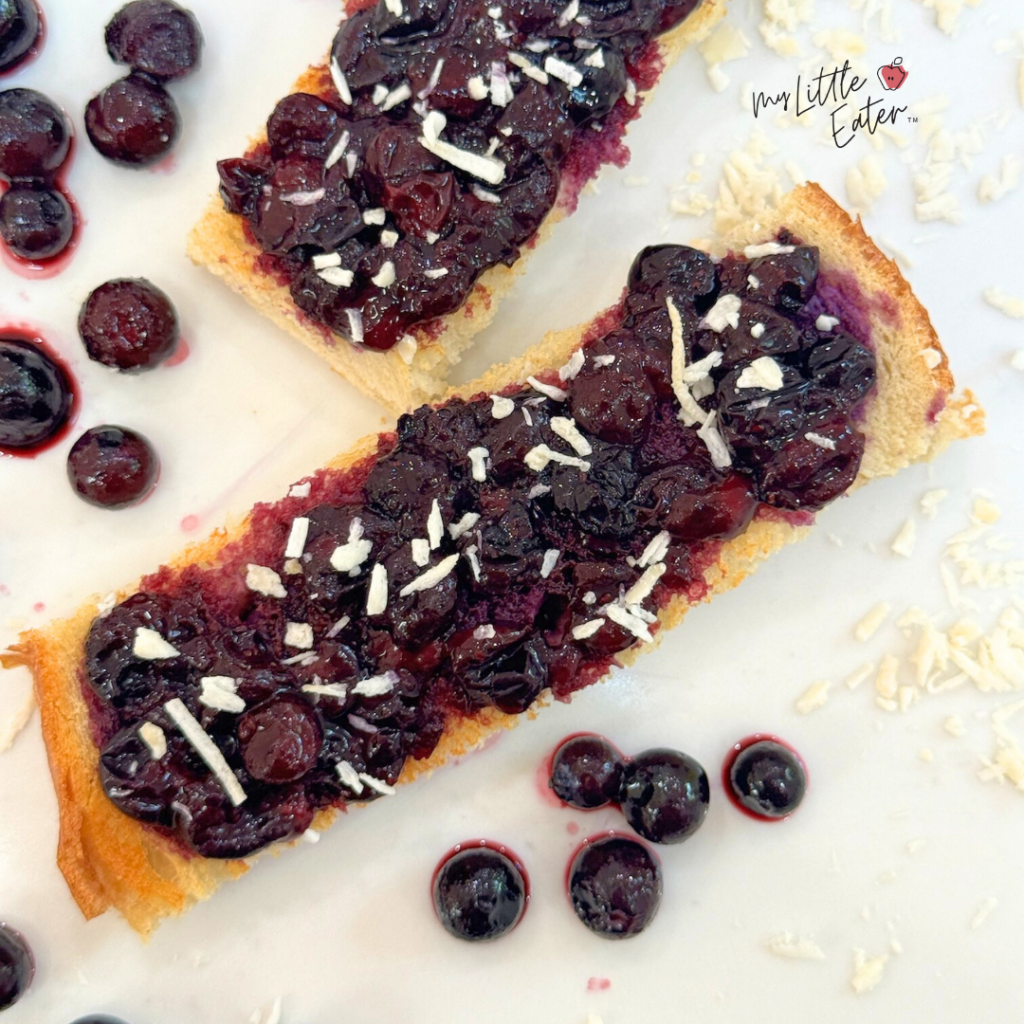
For extra flavor and a nutritional boost, try pairing mashed berries with any of the following ingredients:
- Mint
- Hemp hearts
- Chia seeds
- Flaxseed
- Labneh*
- Lemon juice
- Ground nuts*
- Plain Greek yogurt*
- Unsweetened shredded coconut
- Nut butter (peanut, almond, cashew, etc.)*
- Seed butter (sunflower, pumpkin, etc.)
Mashed Salmon*
Fish offers so many great benefits for your baby and toddler. It’s high in protein, iron, B12, vitamin D, and calcium, and is often high in DHA, which is very important for proper brain growth and eye development (4, 5). We recommend serving fish to your baby a couple of times a week, especially fatty fish.

Canned salmon is an excellent choice for a toast topping, as it’s convenient and one of the best sources of DHA. When choosing canned salmon, be sure to select one in a BPA-free can with no added salt.
For extra flavor and a nutritional boost, try pairing salmon with any of the following ingredients:
- Mayo* + pepper
- Mayo* + dill + lemon
- Mayo* + parsley
- Mayo* + green onion
- Mayo* + garlic powder
- Greek yogurt* + dill
- Greek yogurt* + green onion
Learn more about safe fish for babies, plus get a list of our top recommendations and which ones we suggest you avoid.
Mashed Sardines*
Canned sardines are another fantastic option for a toast topping. They’re low in mercury, high in DHA, protein, and iron (6). Best of all, most babies LOVE them!
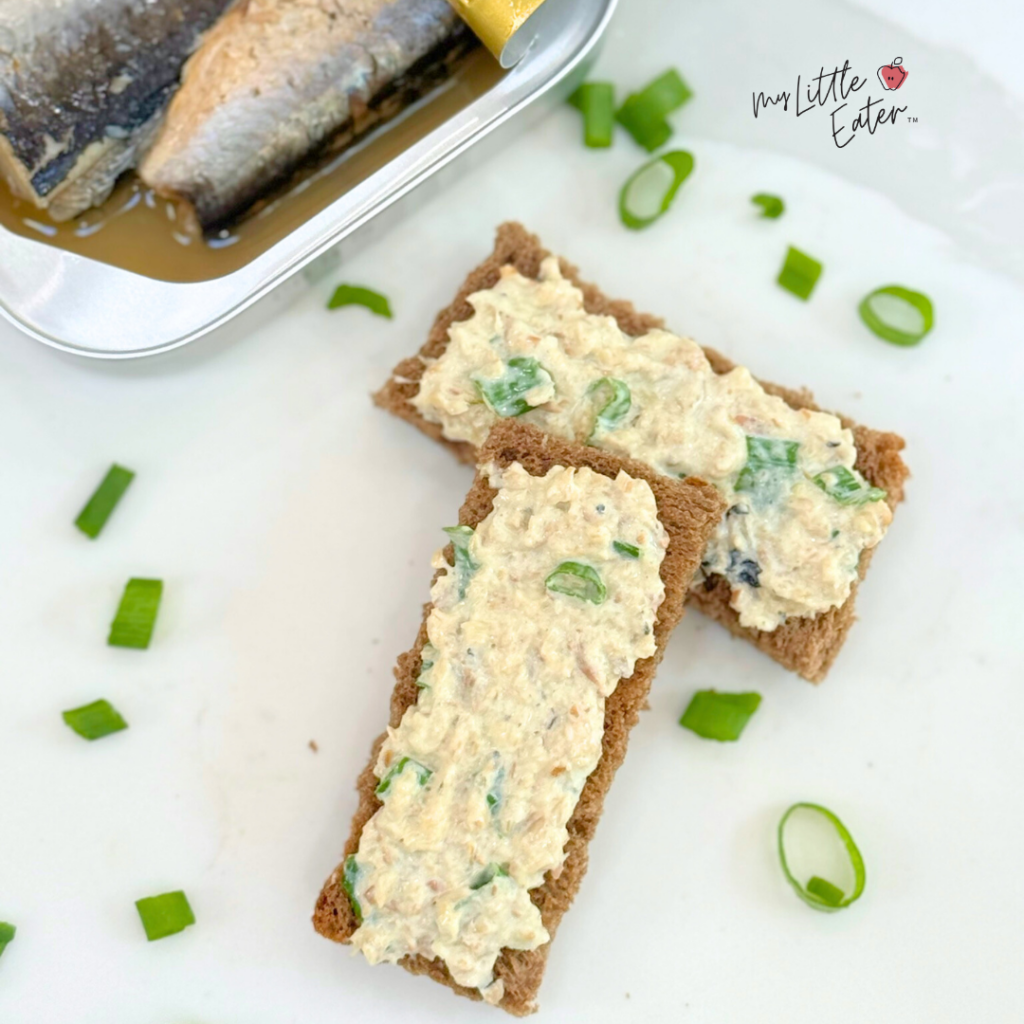
Introducing different types of fish can expose your baby to a variety of tastes, smells, and textures, helping to expand their palate and list of accepted foods.
For extra flavor and a nutritional boost, try pairing sardines with any of the following ingredients:
- Avocado
- Mayo* + pepper
- Mayo* + parsley
- Mayo* + green onion
- Mayo* + garlic powder
- Mayo* + dill + lemon
- Greek yogurt* + dill
- Greek yogurt* + green onion
Puréed liver
We know liver might not be everyone’s idea of a tasty meal, but hear us out – it’s one of the most nutritious foods you can offer your baby! As a toast topping, liver provides a significant boost of vitamins and minerals, including iron, vitamin B12, and zinc (7).
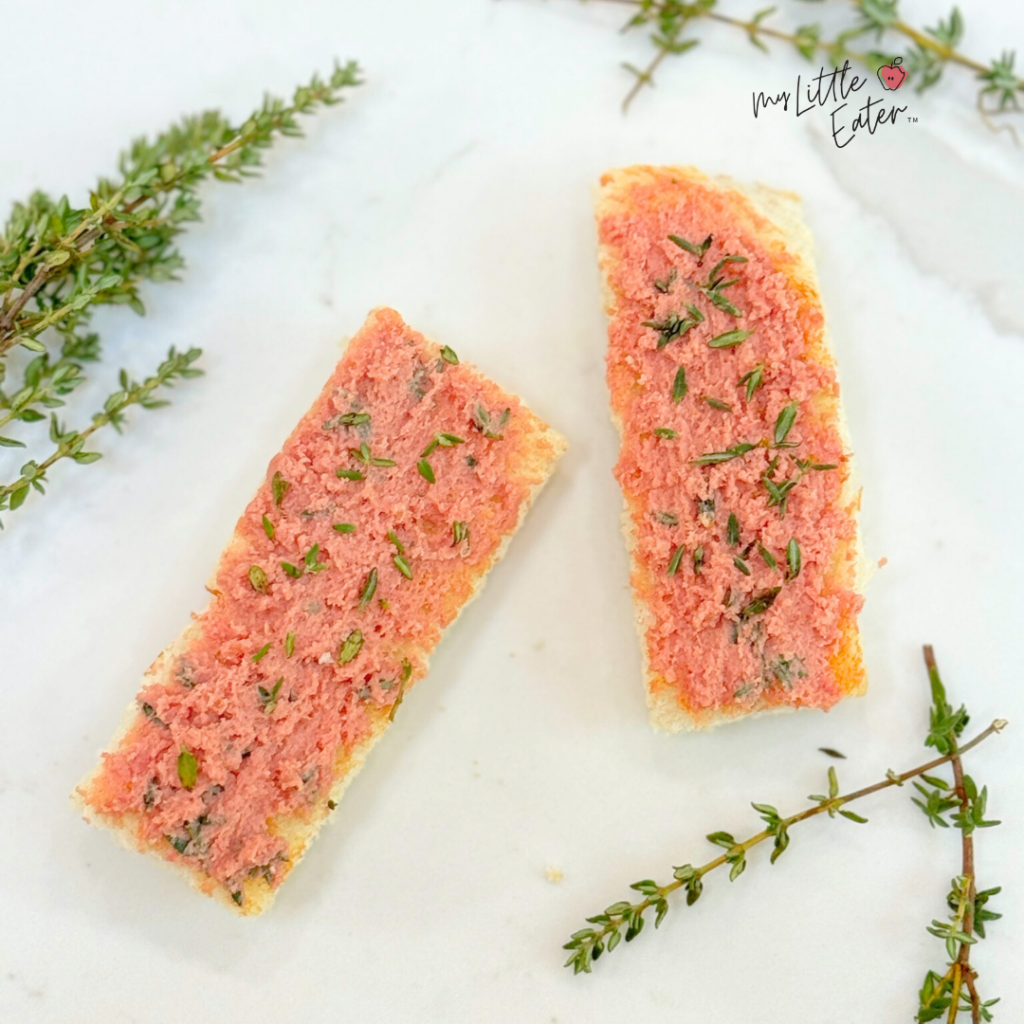
However, it’s important to note that liver contains very high levels of vitamin A (7). While this nutrient is important for the development of your baby’s immune system, eyes, and skin, consuming too much can pose a small risk of vitamin A overload.
We recommend serving liver no more than once per week.
For extra flavor and a nutritional boost, try pairing liver with any of the following ingredients:
- Thyme
- Cumin
- Lemon
- Dill
- Rosemary
- Garlic powder
- Onion powder
- Plain Greek yogurt*
- Blueberries (mashed or homemade jam)
Mashed beans
Beans and lentils make an excellent toast topping, as they’re rich in iron and help your baby meet their daily iron needs (8, 9). Before babies develop their pincer grasp, this is a fantastic way to include beans in their diet, which might otherwise be difficult for them to pick up unless prepared as a burger.
Simply mash the beans or lentils with the back of a fork and spread them on the toast!
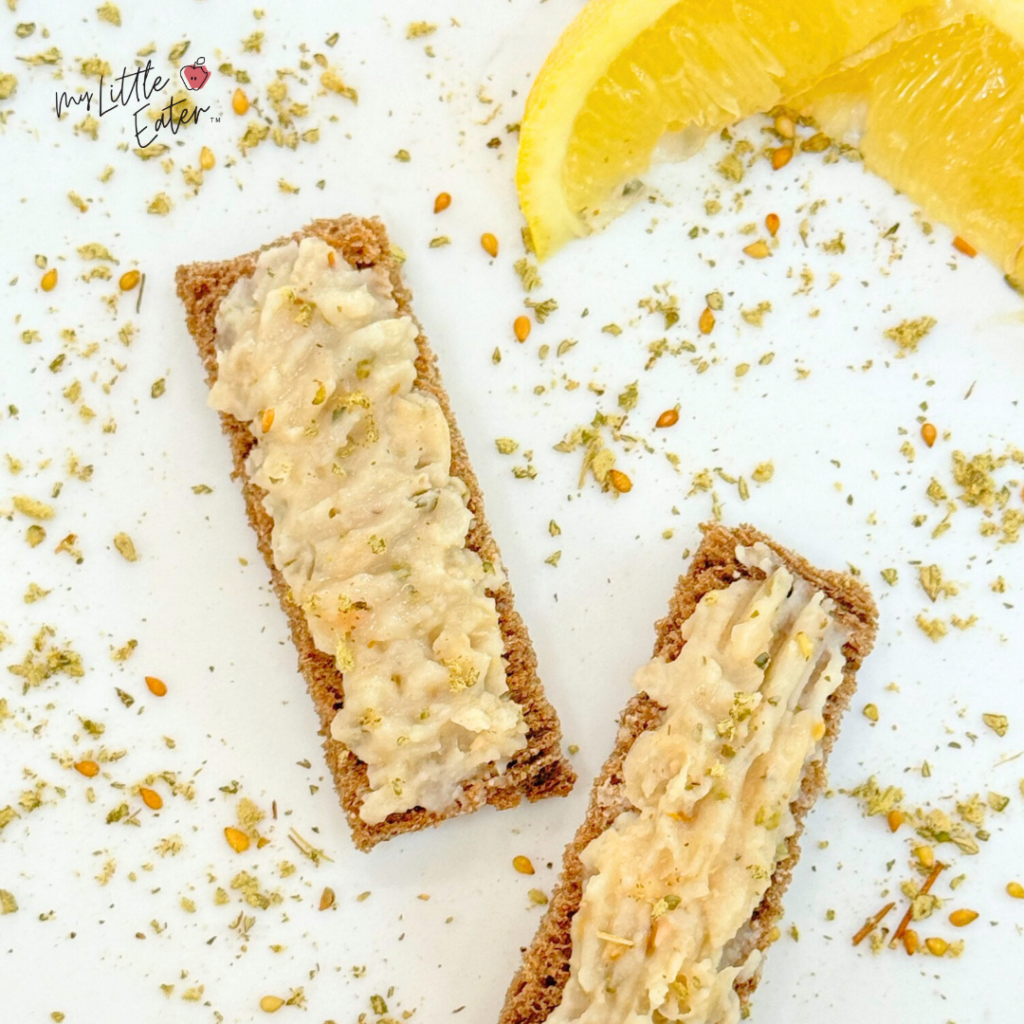
Canned beans, lentils, or chickpeas are a quick and healthy option. Try to choose those stored in a BPA-free liner, and opt for low or no-salt versions when possible. If you have a higher-salt variety, rinse the beans, lentils, or chickpeas under water once or twice to remove some of the excess salt—and voilà! They’re ready to serve without any cooking required.
For extra flavor and a nutritional boost, try pairing beans with any of the following ingredients:
- Cumin
- Hemp hearts
- Lemon juice
- Garlic powder
- Onion powder
- Zaatar spice*
- Cottage cheese*
Bonus tip: To increase iron absorption, add a source of vitamin C to the meal. We suggest squeezing a bit of lemon juice on top of the bean mixture. This is something you can do for any of the ingredient combinations listed above.
Minced Chicken
Chicken is another great toast topping that’s going to provide your baby with lots of iron – particularly dark meat, like chicken thighs or drumsticks!
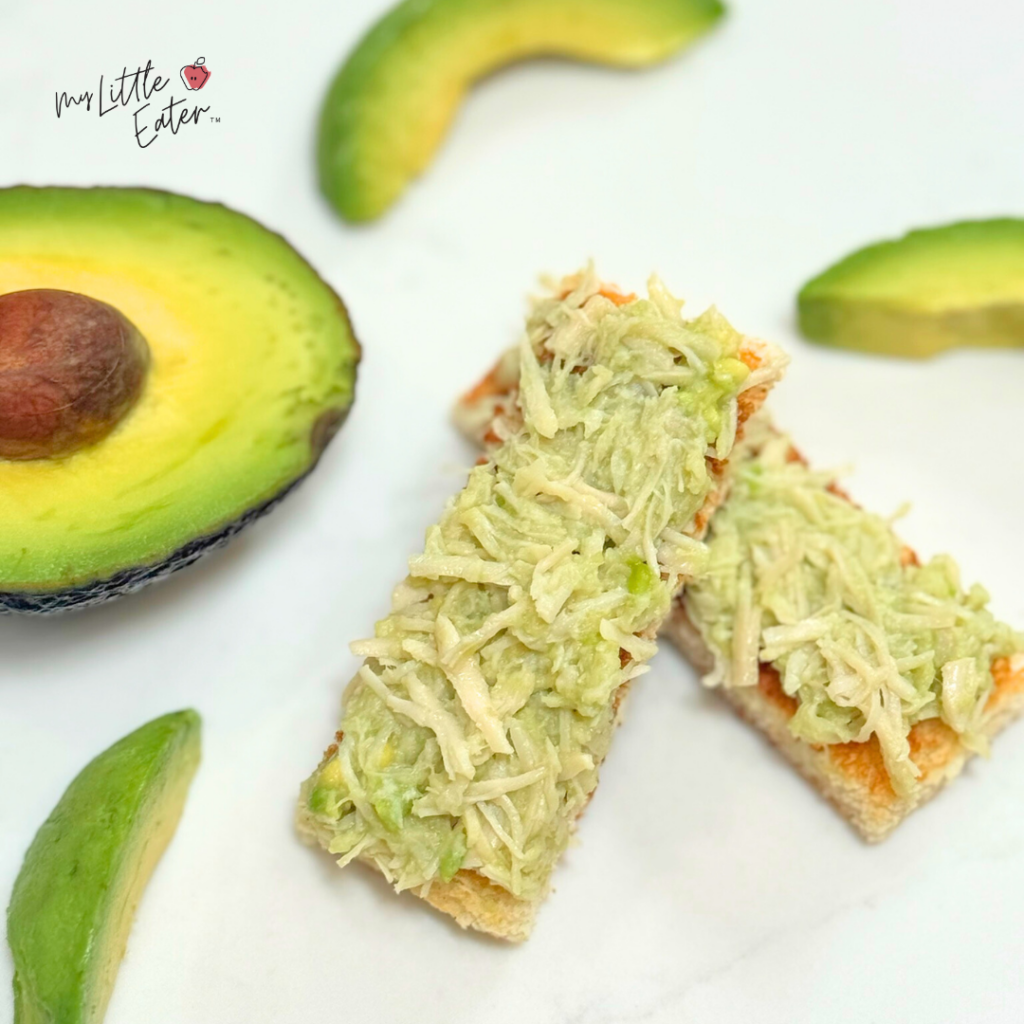
We recommend getting babies used to the taste of chicken and other meat early on. Practicing chewing the complex texture of chicken is important so that they can learn how to consume it in decent quantities before their natural iron stores are completely depleted.
You can offer very soft pulled pieces of chicken through cooking methods like a slow cooker, braised chicken, or even baked chicken thighs or drumsticks. Make sure to keep the skin on while cooking to keep it extra juicy and moist (but remove it before serving it to your baby).
For extra flavor and a nutritional boost, try pairing chicken with any of the following ingredients:
- Mayo* + avocado
- Mayo* + curry
- Mayo* + paprika
- Mayo* + green onion
- Mayo* + mustard* (ground mustard seed)
- Greek yogurt* + dill + lemon
- Greek yogurt* + hemp
- Greek yogurt* + green onion
Nut* or seed butter
Nut and seed butters are great to add as a toast topping as they provide an excellent source of healthy fats for your little one (10)! Choose an all-natural version (just the nut/seed, oil, and maybe salt). Avoid overly processed ones with added sugar, canola oil, or other ingredients.
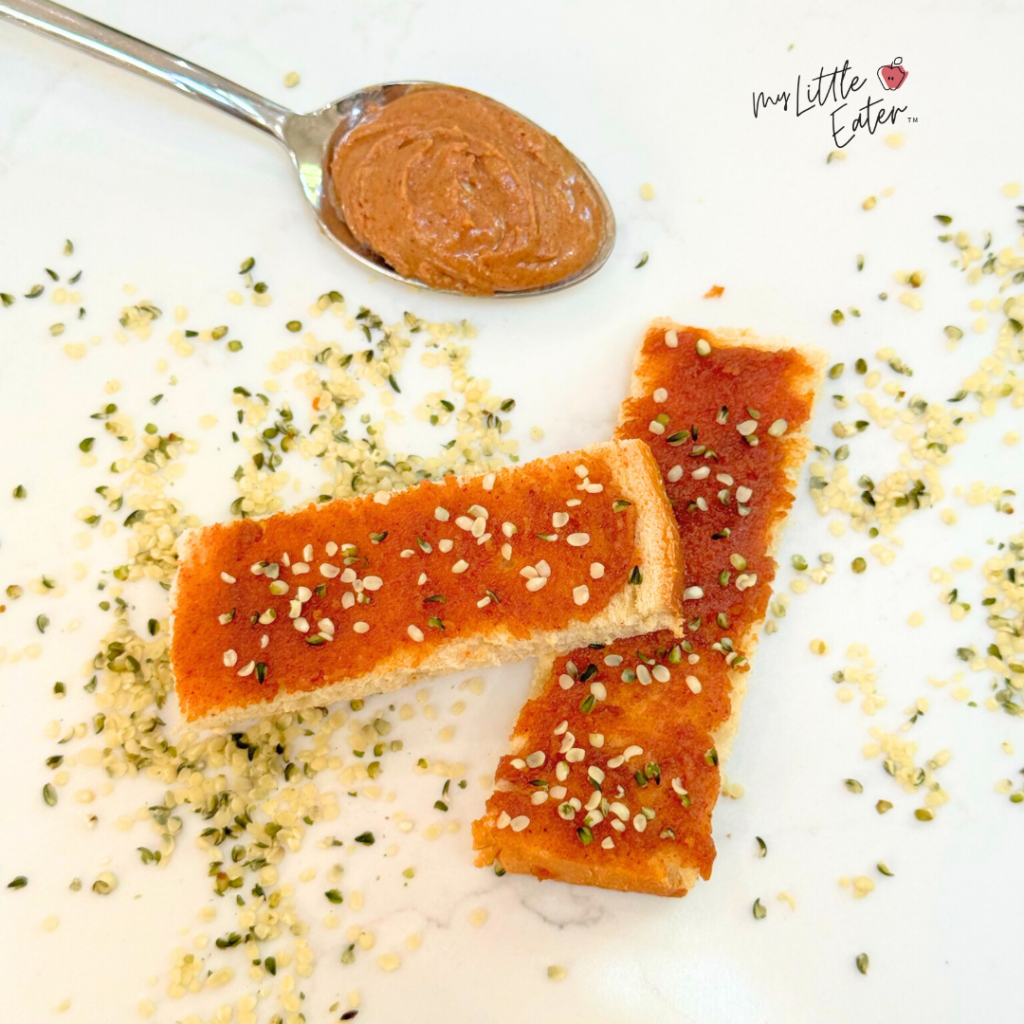
Our favorite options are by nomz – they have 4 types of nut butter (almond, macadamia, hazelnut, and pistachio). All are delicious and made with just a single ingredient! They’re perfect for introducing these tree nuts to your baby for the first time. Use our code MYLITTLEEATER for 10% off your purchase!
For seed butters, you could try sunflower seed butter or pumpkin seed butter – both are delicious!
It’s important to note that nut and seed butter should be spread in a thin layer on toast, as large amounts are sticky and can become a choking hazard.
For extra flavor and a nutritional boost, try pairing nut or seed butter with any of the following ingredients:
- Chia seeds
- Bananas
- Hemp hearts
- Flaxseed
- Mashed berries
- Plain Greek yogurt*
- Unsweetened shredded coconut
- Cottage cheese*
- Labneh*
Cheese* spread
Dairy products are a great source of protein, fat, and calcium for your little one (11)!
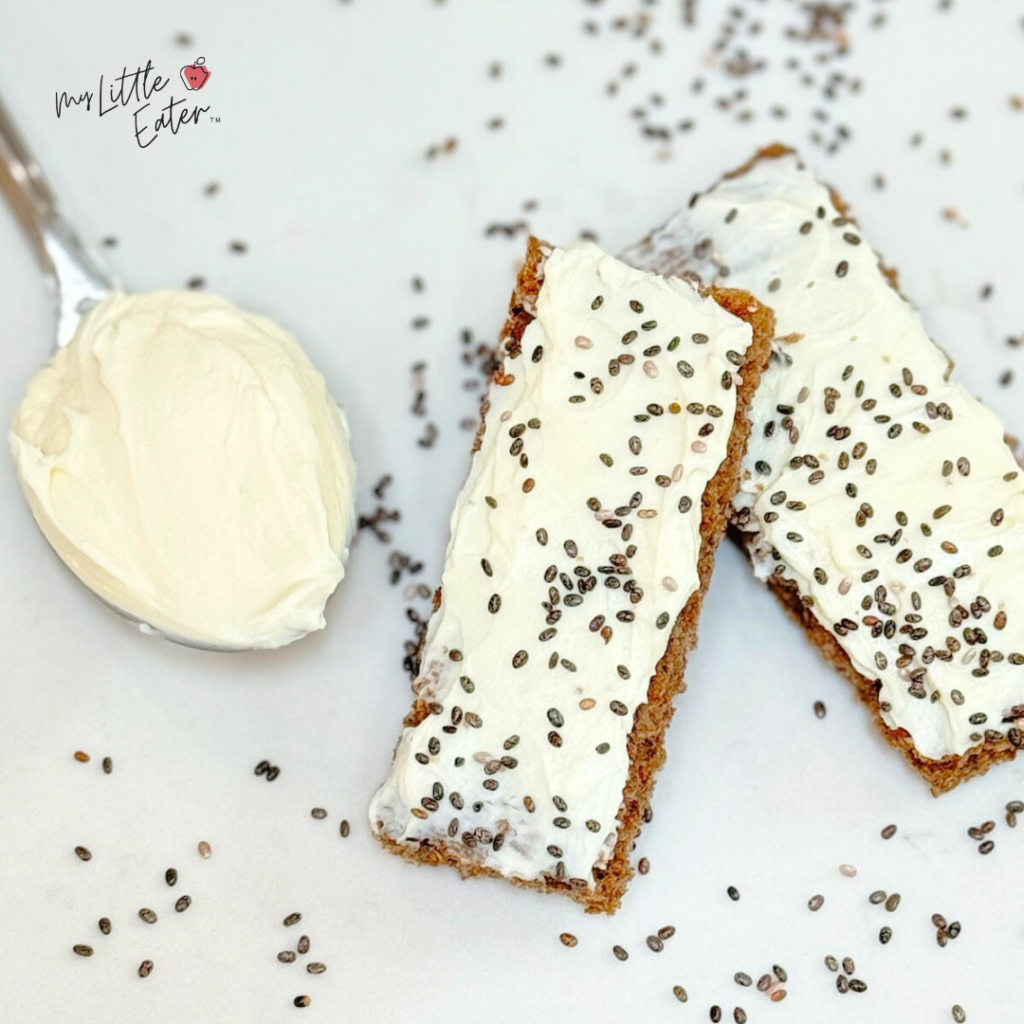
Watch the sodium content in cheese if using it as a toast topping, as it tends to be a little high. If adding cottage cheese as a topping, you can dilute the cottage cheese in a little bit of plain yogurt so that there will be less salt per serving. Another easy swap to make would be to opt for homemade Labneh over cream cheese on toast.
We don’t want you to stress about this too much though, just be aware of it and try to offer other foods that are low sodium options throughout the day, or the next day, to balance it. Learn more about salt for babies and why we don’t need to worry as much as you may think.
For extra flavor and a nutritional boost, try pairing cheese with any of the following ingredients:
- Dill
- Chia seeds
- Salmon*
- Sardines*
- Avocado
- Thinly sliced cucumber
- Ground nuts*
- Mashed berries
- Mashed tomatoes
Hummus*
Hummus is another one of our easy healthy toast ideas that offers a great calorie add-on and source of healthy fat! Hummus also comes in many different flavor combinations, such as roasted red pepper and roasted garlic, that will add variety to your baby’s meal.
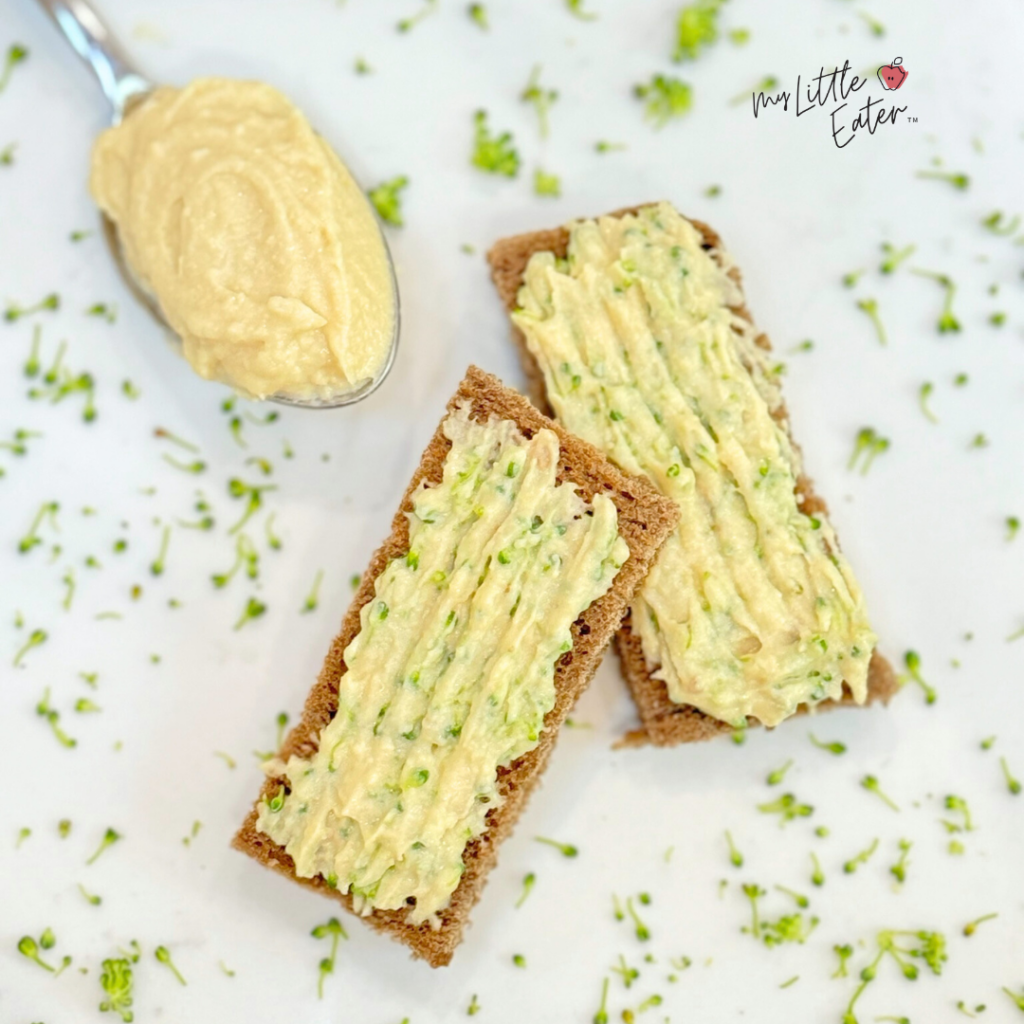
It’s important to note that hummus often contains tahini as an ingredient, which is made out of sesame seeds, a highly allergenic food. That is why we have it marked with an asterisk, be sure to check the ingredient list to see if it contains tahini, or if it has a label stating it contains sesame.
For extra flavor and a nutritional boost, try pairing hummus with any of the following ingredients:
- Mashed veggies (like broccoli)
- Hemp hearts
- Chia seeds
- Flaxseed
- Garlic powder
- Onion powder
- Zaatar spice*
- Ground nuts*
- Green onion
- Salmon*
- Chicken
- Sardines*
Benefits of healthy toast toppings for babies
Adding toppings to toast provides a healthy, nutrition-packed, and balanced meal for your baby or toddler (without being too time-consuming).

There are other reasons for using various topping combinations to increase your baby’s exposure to different foods, textures, and flavors – let’s get into them!
Adds variety and expands taste buds
Did you know that the time between the ages of 6-9 months is a critical period for promoting adventurous eating and avoiding the pitfalls of picky eating?
It’s true! Babies are much more likely to accept new foods and flavors during this period of time. Offering a variety of different toast toppings on your baby’s toast is an easy way to expand their taste buds and “taste train” them, if you will, without adding a whole bunch of cooking for you!
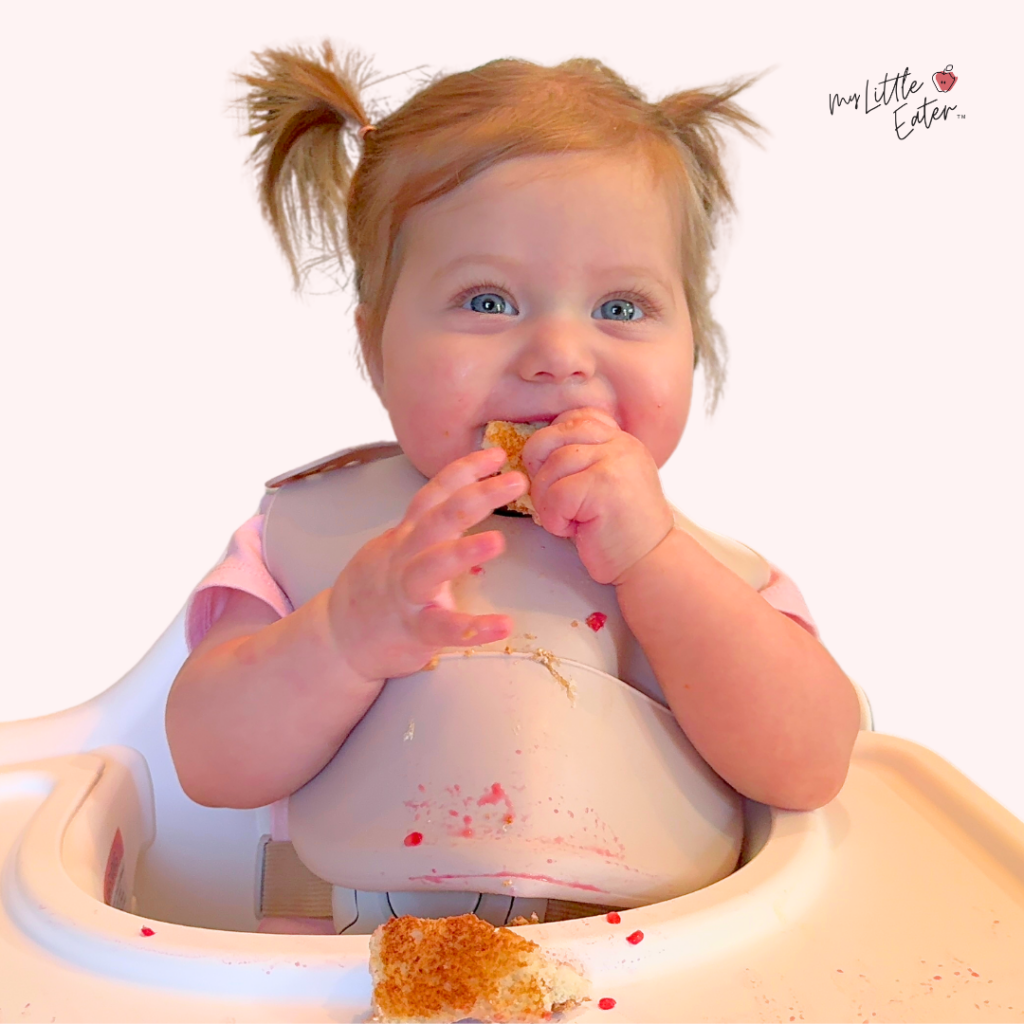
With toddlers, it’s important to make sure that food is showing up in different ways each time we serve it to them (or at least, whenever possible). That’s because toddlers are known to get stuck in food ruts, wanting the same food over and over again, and losing their cool every time something looks different or new.
To help overcome this, we keep even simple foods like toast new and different by simply offering different spreads on top. Instead of the same ol’ peanut butter and strawberry jam, maybe you switch it up to almond butter and blueberry jam – or a different spread altogether!
This is a classic strategy that can be built on to really help expand your picky eater’s diet – all found inside our Feeding Toddlers online course. Check it out if you’re looking to make changes to how your toddler eats to prevent or overcome picky eating.
Lets babies taste hard-to-eat foods
Toast toppings are a great way for your baby to eat foods that they otherwise might not be able to eat easily. For example – flaked salmon or beans are hard for babies to pick up with their fingers until they develop their pincer grasp (around 8/9 months old).
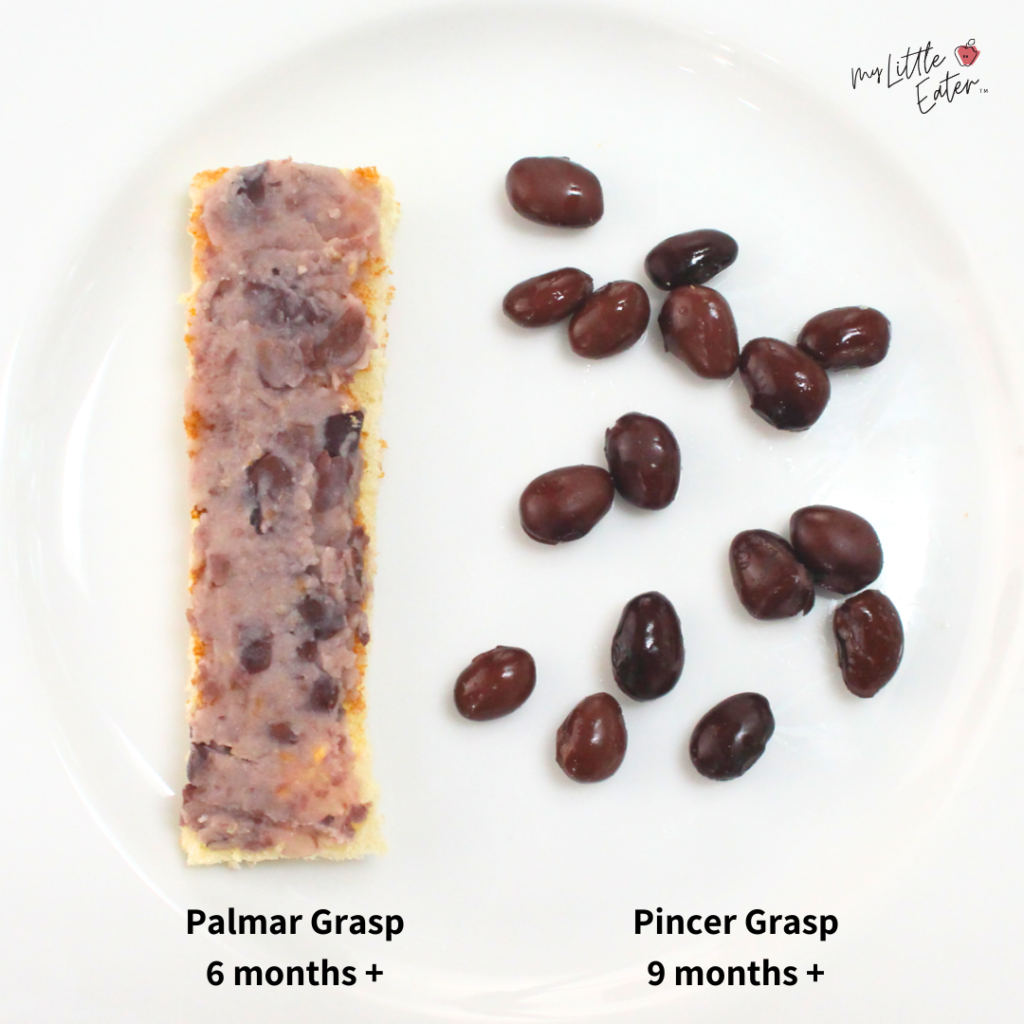
Nut butter forms into big globs and is too thick on a spoon, which poses a choking hazard.
Avocado can be slippery, making it difficult for your baby to hold onto and bring to their mouth.
You get the point.
Mashing hard-to-pick-up foods and spreading them on toast is an easy way to include foods in your baby’s diet that provide specific nutrients they need.
Makes toast easier and safer for babies to eat
Dry toast without any toppings poses an increased risk of choking for both babies and toddlers. It’s very hard to chew and requires a lot of saliva production to moisten it enough so that it can be safely swallowed.

Toppings will ensure the toast is moist so that it’s easier and safer for babies to eat and swallow!
Learn more about choking hazards for babies and toddlers.
Creates balanced meals and snacks
On its own, toast provides a great source of carbohydrates and, depending on the type of bread, contains some fiber as well! But – carbohydrates and fiber aren’t enough to make up a balanced meal. Instead, we recommend always adding a topping that follows our FFP™ Rule for balanced meals.
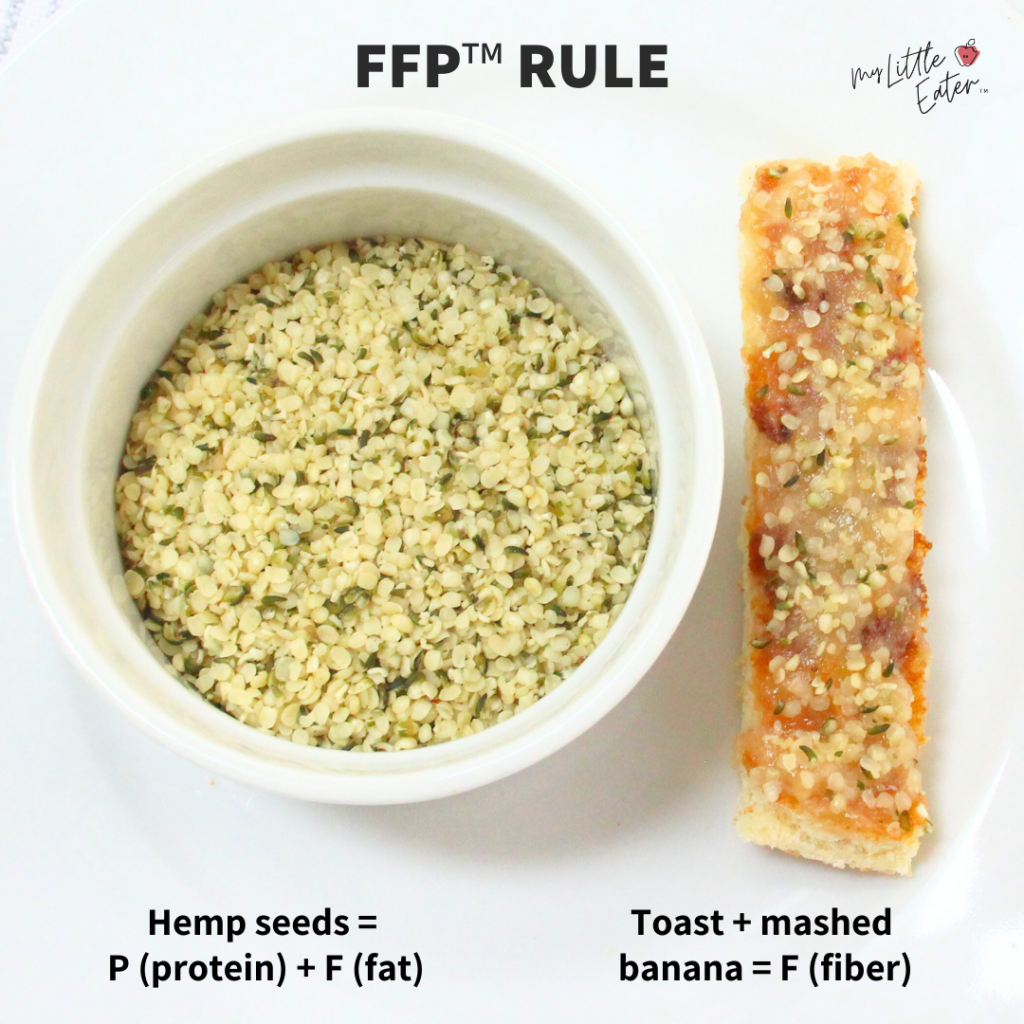
This is an easy formula for building meals and snacks that we always recommend to clients. FFP™ simply stands for Fat, Fiber, and Protein. The rule is that every meal should include a good source of each of these three major nutrients, while snacks should include at least two out of the three nutrients.
Since toast is part of the fiber category, you need to add toppings from the protein and/or fat category to create a more balanced plate for your baby or toddler. This will provide more calories, and the right mix of nutrients, which will better balance their blood sugars and keep them full until their next meal or snack.
For babies particularly, it’s also important to include a high-iron food at least twice a day to ensure they meet their iron needs (which are very high at 11.4mg per day). Adding a toast topping that’s a good source of iron like beans, eggs, salmon, or liver is an easy way to help them get the iron they need.
Toast toppings to avoid for babies
Added sugar
In general, it’s recommended to avoid or limit added sugars for children until around 2 years of age because they can:
- Increase your baby’s affinity for sweet foods.
- Provide excess calories with no nutritional value.
- Raise your baby’s blood sugar levels.
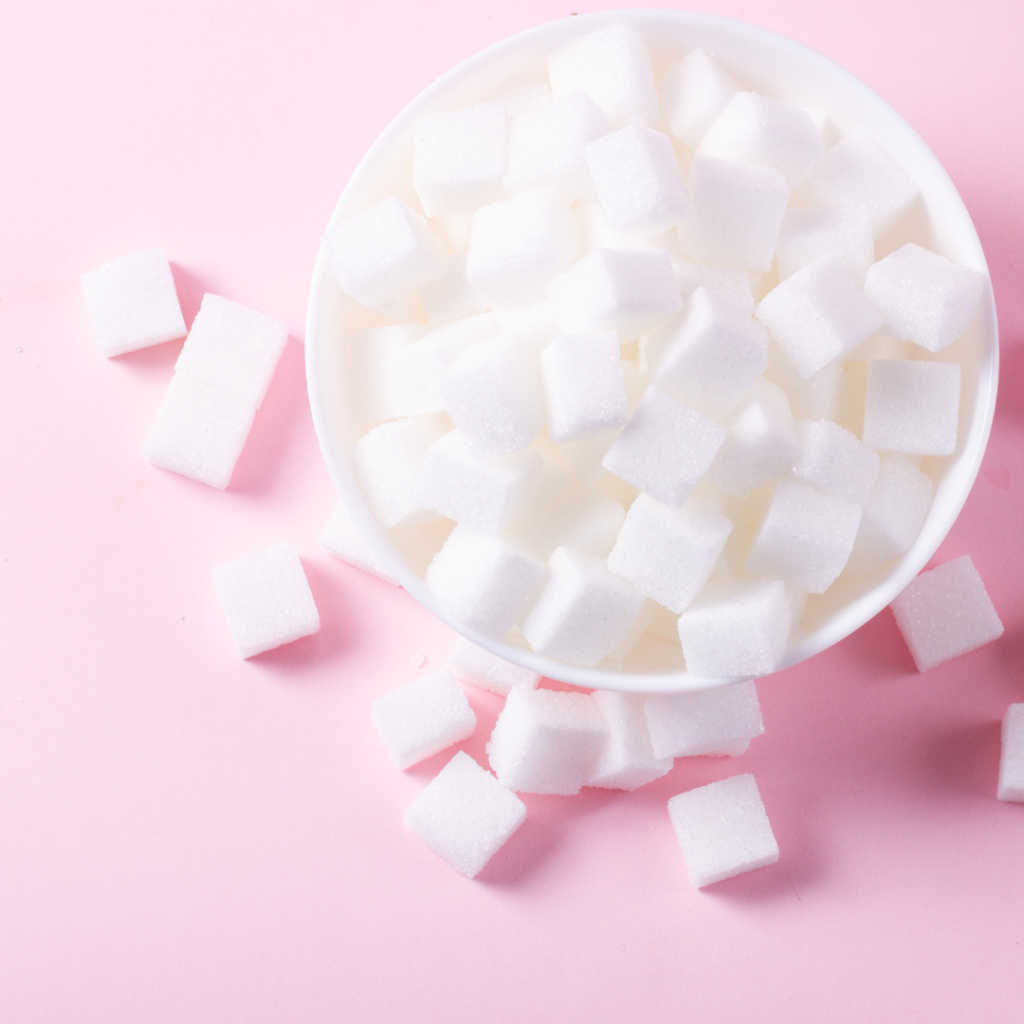
One popular toast topping for kids is Nutella hazelnut spread, where the first ingredient listed is sugar. We recommend avoiding it entirely until your child is at least 2 years old.
Peanut butter is another favorite, but many varieties contain added sugar. Instead, we suggest choosing an all-natural peanut butter, which typically contains only peanuts and no unnecessary ingredients.
The great news is that you don’t have to depend on sugary spreads. We’ve shown you numerous toast topping options without added sugar that will give your baby the essential nutrients needed for optimal growth and development (while still being tasty!).
Added salt
Many toast toppings, such as certain cheeses, butter, canned foods (like meat, seafood, beans, etc.), and condiments (like mayonnaise), can be high in salt.
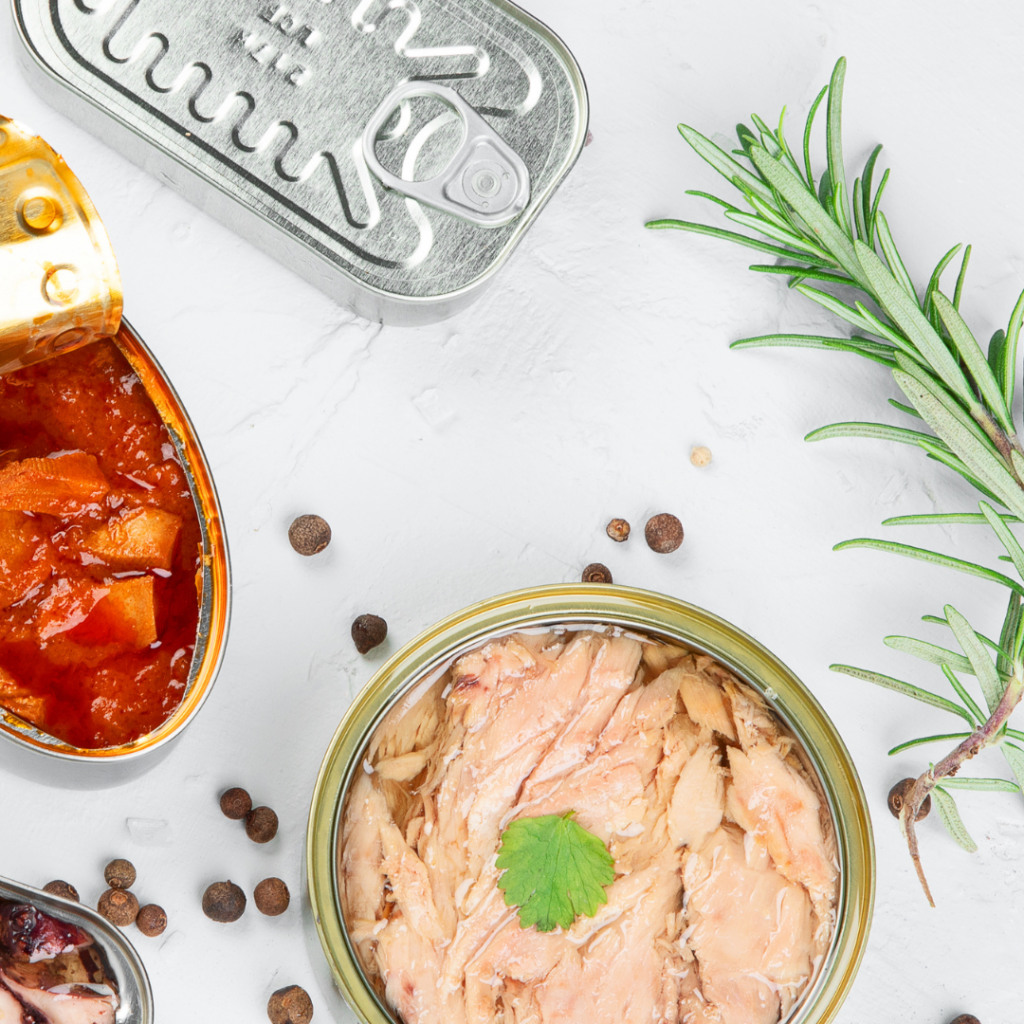
When choosing toast toppings that contain salt, aim for varieties with less than 100mg of sodium per serving, or if possible, no salt at all. For canned foods, look for options labeled “no added salt” or “salt-free.”
If you want to know more about salt recommendations for babies (and how you don’t have to freak out about it as much as we’re sometimes made to think we should), check out our blog – The Truth About Salt For Babies!
Honey
Babies younger than 1-year-old should not be given honey in any form as it contains a type of bacteria that can cause infant botulism (12). This can result in serious illness with symptoms such as (12):
- Weak muscles
- Lack of facial expression
- Trouble breathing
- Inability to swallow
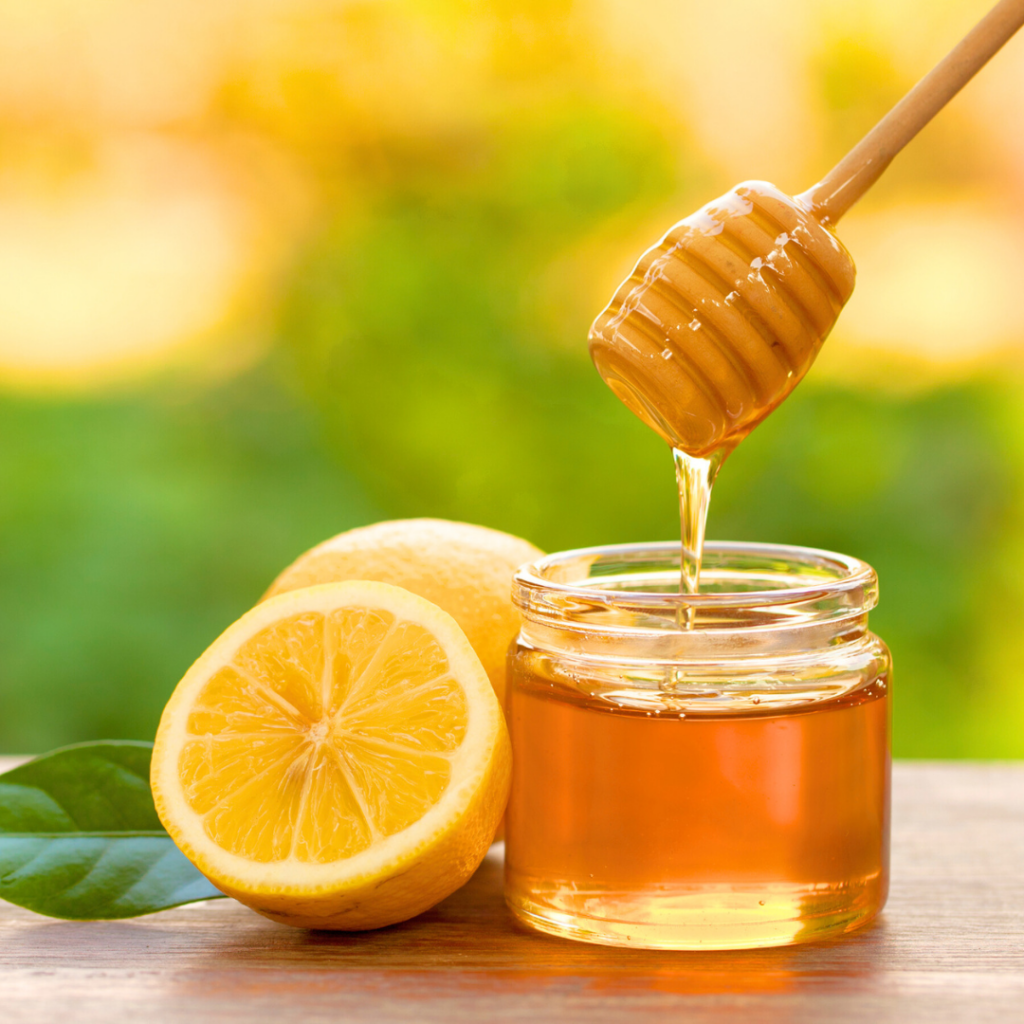
It’s important to note that pasteurization or baking doesn’t kill the spore – so the safest is to completely avoid it before 1 year of age – in ALL products. This includes when choosing the type of bread for your baby’s toast. Always check ingredient labels to ensure no honey is present.
After age 1, we know that babies’ digestive and immune systems have developed enough to pass the spore through the body. Making it safe for them to consume at that point.
Toast FAQ’s
What type of bread do I choose for my baby?
With so many options for bread these days, it can be time-consuming to read all the labels and figure out which bread is best for your baby.
A couple of key things to note when choosing the best bread, are:
- Make sure that there are no large seeds, like pumpkin or sunflower seeds, in the bread as they’re choking hazards for babies and young toddlers.
- Ensure that the bread is free of honey as an ingredient for babies under 1 year old.
- Switch it up by not always opting for basic whole grain breads. Pumpernickel, sourdough, and other breads can be used as well.
To learn more about our other recommendations on choosing the best bread for your baby, including what to check for on the nutrition label, see our blog post all about bread for babies. We also include our top brand recommendations to help narrow down your search while shopping!
Should I serve fresh bread or toast to my baby?
For babies, we always recommend toast! Fresh, soft bread is considered to be a choking hazard, as mentioned above. This is because it tends to gum up and can form a ball in your baby’s mouth, which could then get lodged in the airway. When prepared properly, the risk is greatly reduced.
To help prevent choking, lightly toast the bread until it’s slightly firm. This also makes it easier for your baby to hold as it won’t be too soft and therefore won’t fall apart as easily.
We always get a ton of questions on how long to toast the bread, but honestly, this varies and depends on the type of bread you’re using, and what toaster you have! Generally, you want to toast the bread until it becomes a light brown color and can break apart easily. If it’s toasted for too long, it may become too crunchy and dry.
When can babies eat bread un-toasted?
This will depend on your child and their chewing skills. Generally, around 18 months of age is when they’ll have developed their chewing skills enough that they can safely move un-toasted bread around in their mouth, even if it gums up a bit.
We recommend continuing to lightly toast bread until then, at which point you can try a bit of un-toasted bread to see how they do. Continue toasting it if you notice they struggle with it, or if you just feel more comfortable giving them a bit more time.
At the end of the day, you know your baby best and are the one who is best equipped to decide whether your baby can handle something new like this.
How to cut lightly toasted bread for babies under 12 months old?
Cut lightly toasted bread into narrow and long strips, or finger shapes, that make it easier for your baby to hold.
When offering toast in long strips, you can let your little one dip the toast strips into foods like applesauce or yogurt. This is another great way to use toast as a vehicle for added nutrition and texture exposure. Plus, it allows your baby to practice a dipping motion, which helps develop their motor skills.
When your baby or toddler has developed their pincer grasp (typically this happens around 9 months old), you can cut toast into 1” bite-sized pieces that your child can pick up with their forefinger and thumb.
If you’re looking for baby-friendly recipes, don’t forget to check out our 60 Day Baby Led Feeding Meal Plan! Take the stress out of deciding what meals to serve and how to safely serve them to your baby with access to over 60 dietitian-approved recipes, weekly grocery lists, serving and nutrition tips, and more!

Pin this to save for easy & healthy meal or snack inspiration!

References
- Comerford, K. B., Ayoob, K. T., Murray, R. D., & Atkinson, S. A. The role of avocados in complementary and transitional feeding. Nutrients, 8(5), 316, 2016.
- Netshiheni, R. K., Omolola, A. O., Anyasi, T. A., & Jideani, A. I. Banana bioactives: absorption, utilisation and health benefits. In Banana nutrition-function and Processing Kinetics (pp. 1-20). IntechOpen, 2019.
- Filipiak-Florkiewicz, A., Deren, K., Florkiewicz, A., Topolska, K., Juszczak, L., & Cieslik, E. The quality of eggs (organic and nutraceutical vs. conventional) and their technological properties. Poultry science, 96(7), 2480–2490, 2017.
- Lund E. K. (2013). Health benefits of seafood; is it just the fatty acids?. Food chemistry, 140(3), 413–420. https://doi.org/10.1016/j.foodchem.2013.01.034
- Lewin, G. A., Schachter, H. M., Yuen, D., Merchant, P., Mamaladze, V., & Tsertsvadze, A. (2005). Effects of omega-3 fatty acids on child and maternal health. Evidence report/technology assessment (Summary), (118), 1-11.
- U.S. Department of Agriculture. FoodData Central. https://fdc.nal.usda.gov/fdc-app.html#/food-details/1855460/nutrients
- U.S. Department of Agriculture. FoodData Central. https://fdc.nal.usda.gov/fdc-app.html#/food-details/169451/nutrients
- Khrisanapant, P., Kebede, B., Leong, S. Y., & Oey, I. (2019). A Comprehensive Characterisation of Volatile and Fatty Acid Profiles of Legume Seeds. Foods (Basel, Switzerland), 8(12), 651. https://doi.org/10.3390/foods8120651
- Kimothi, S., & Dhaliwal, Y.S. (2020). Nutritional and Health Promoting Attribute of Kidney Beans (Phaseolus vulgaris L.): A Review. International Journal of Current Microbiology and Applied Sciences. 9(5). 1201-1209. https://doi.org/10.20546/ijcmas.2020.905.134
- Richardson, D.P., Astrup, A., Cocaul, A., & Ellis, P. (2009). The nutritional and health benefits of almonds: a healthy food choice. Food Science & Technology Bulletin: Functional Foods. 6(4). 41-50. DOI: 10.1616/1476-2137.15765
- McCarthy, A. L., O’Connor, T. P., & O’Brien, N. M. Cheese in the context of diet and nutrition. In Handbook of cheese in health: Production, nutrition and medical sciences (pp. 5-8). Wageningen Academic Publishers (2013).
- Government of Canada. Infant Botulism. 2023. Retrieved from https://www.canada.ca/en/health-canada/services/food-safety-vulnerable-populations/infant-botulism.html

Chelsey Landry, RD
Community Dietitian at My Little Eater Inc., and bunny-mom to Hickory. Chelsey offers one-on-one counselling to parents of babies and toddlers that need more customized support. Learn more by booking a free discovery call with her today!

Chelsey Landry, RD
Community Dietitian at My Little Eater Inc., and bunny-mom to Hickory. Chelsey offers one-on-one counselling to parents of babies and toddlers that need more customized support. Learn more by booking a free discovery call with her today!








